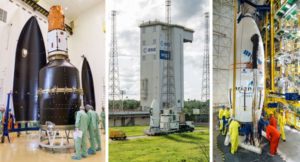
Build-up of the lightweight Vega for Arianespace’s upcoming mission to orbit twin Earth observation satellites is complete in French Guiana, with the OPTSAT-3000 and Venµs spacecraft now integrated with their launch vehicle.
During activity on the Spaceport’s space launch vehicle (SLV) launch site, the two passengers – which are integrated in their payload fairing – were installed on Vega, topping off the vehicle composed of three solid-propellant stages and a liquid bipropellant upper stage.
Vega will now undergo final preparations and checkout leading to a nighttime liftoff on August 1, 2017 (local time in French Guiana), for Arianespace Flight VV10, marking the 10th mission for this vehicle since its 2012 service entry.
As the smallest member in Arianespace’s launcher family, Vega complements the company’s medium-lift Soyuz and heavyweight Ariane 5 in providing a full range of launch services for customers worldwide. ELV/Avio is the vehicle’s production prime contractor.
OPTSAT-3000 to be deployed first by Vega
To be deployed first during the mission to Sun-synchronous orbit is OPTSAT-3000 – an Earth observation satellite for the Italian Ministry of Defense. Built by Israel Aerospace Industries (IAI) based on inter-governmental Italian-Israeli agreements, it will enable national defense entities to acquire and use high-resolution images from any part of the globe.
The OPTSAT-3000 system was supplied by Telespazio as prime contractor, which has responsibility for the entire system: from the satellite to the ground segment, launch and early operation services, the preparation and execution of operations and logistics, through to in-orbit tests and commissioning. OHB Italia is responsible for the launch services and related engineering support.
With a design life exceeding seven years, OPTSAT-3000 has a liftoff mass of 368 kg.
Venµs puts the focus on Earth vegetation
Riding in the lower payload position on Vega is Venµs, an Earth observation and exploratory mission for the Israeli Space Agency (ISA) and France’s CNES space agency at the benefit of the Israeli Ministry of Science and Technology.
As the first Israeli-made satellite created for environmental research purposes, Venµs was developed by Israel Aerospace Industries’ Space Division, with Rafael providing the propulsion system. The spacecraft has a liftoff mass set at 264 kg.
CNES is in charge of the multi-spectral camera, its image programming and processing, as well as the distributing ground station, with the camera’s development performed for CNES by Elbit Electro-Optic Systems Elop Ltd.
Venµs – which is the acronym for Vegetation and Environment on a New Micro Satellite – will study the evolution of the Earth’s vegetation during its scientific mission, while the satellite’s technological mission will provide in-flight qualification of the Israeli Electrical Propulsion System, based on Hall-Effect thrusters.
Flight VV10 will be Arianespace’s eighth mission of 2017. It follows the launches of four Ariane 5s, two Soyuz vehicles and one Vega so far this year.
Original published at: https://spacewatch.global/2017/07/israels-iai-built-optsat-3000-ven%c2%b5s-payloads-received-arianespace-vega-august-1-launch/
 SpaceWatch.Global An independent perspective on space
SpaceWatch.Global An independent perspective on space

